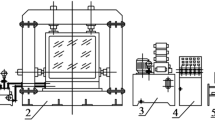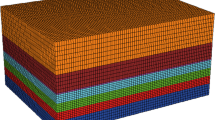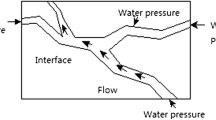Abstract
A physical simulation test system was designed to study the mechanism of water inrush through the mine floor. The results showed that vertical stress in the floor first increased as the mining face approached, then decreased after the face had passed, and finally returned to near its original state as the mine roof falls. At about the same time, the floor first experienced compression as the mining face approached, then heaving after the face had passed, and finally recompression to a position that was a little higher than its original height. Water inrush occurred before the first weighting of the roof but there were no subsequent water inrushes.
摘要
设计物理模拟试验研究了底板突水机理。研究结果表明,煤层底板垂向应力随工作面接近增大、工作面通过后降低和顶板垮落后恢复至近初始状态;同时,底板变形经历了工作面接近时压缩、工作面通过后隆起和最终压缩至比初始状态略高的状态。突水发生于首次顶板来压之前,之后没有发生底板突水。
Zusammenfassung
Ein physisches Simulation-Testsystem wurde entworfen, um die Wirkung des Wassereinbruchs aus dem Liegenden zu studieren. Die Ergebnisse zeigen, dass die vertikalen Spannungen ansteigen, wenn die Abbaufront sich nähert, dass sie fallen, wenn die Abbaufront sich entfernt bis zum ursprünglichen Zustand, wenn das Hangende bricht. Zu gleicher Zeit wird das Liegende unter Druck gesetzt, wenn die Abbaufront sich nähert, wenn diese sich entfernt, eine Dekompression tritt ein bis zu einem Wert etwas oberhalb des Ausgangzustandes. Wassereinbrüche ereignen sind bevor das Hangende aufliegt, danach kommt es zu keinem weiteren Wassereinbruch.
Resumen
Un sistema de testeo por simulación física fue diseñado para estudiar el mecanismo de irrupción de agua a través del piso de una mina. Los resultados mostraron que el estrés vertical en el primer piso se incrementó a medida que se aproximaba la cara de trabajo minero, decrecía cuando la cara había pasado y finalmente retornaba cerca de su estado original cuando el psio de la mina caía. Al mismo tiempo, el primer piso experimentaba compresión cuando la cara de trabajo se aproximaba, disminuyendo después que la cara había pasado para finalmente recomprimirse hasta una posición ligeramente mayor que su altura original. La irrupción de agua ocurrió antes de la primera ponderación del techo pero no hubo subsiguientes irrupciones.







Similar content being viewed by others
References
Cheng T, Guo B, Wang L, Yang X (2016) Numerical analysis on water inrush from floor during mining above confined aquifer at Jiulishan coal mine. Electron J Geol Eng 21:5749–5761
Guo B (2008) Numerical analysis on water-inrush process due to floor heave. J Coal Sci Eng 14:225–229
Hu Y, Zhao Y, Yang D (2007a) Simulation theory & method of 3D solid-liquid coupling. J Liaoning Tech Univ 26:204–206 [Chinese]
Hu Y, Zhao Y, Yang D (2007b) 3D solid-liquid coupling experiment study into deformation destruction of coal stope. J Liaoning Tech Univ 26:520–523 (Chinese)
Huang H, Mao X, Yao B, Pu H (2012) Numerical simulation on fault water-inrush based on fluid-solid coupling theory. J Coal Sci Eng 18:291–296
Li L, Qian M, Yin Y (1997) Research on the tests of water-inrush from floor simulated by similar materials. Coal Geol Explor 25:33–36 (Chinese)
Li S, Xu F, Zhang Q, Li L, Wang W, Liu H (2016) Analysis and construction techniques for a water seal for underground mines subjected to water inrush. Mine Water Environ 35:168–179
Sun W, Zhang S, Li Y, Lu C (2015) Development application of solid-fluid coupling similar material for floor strata and simulation test of water-inrush in deep mining. Chin J Rock Mech Eng 34(S1):3665–3670 [Chinese]
Sun W, Zhou W, Jiao J (2016) Hydrogeological classification and water inrush accidents in china’s coal mines. Mine Water Environ 35:214–220
Wang J, Park H (2003) Coal mining above a confined aquifer. Int J Rock Mech Min Sci 40:537–551
Yang Y, Li K (1997) The water inrush mechanism in coal seam floor by the physical analogy simulation technique. Coal Geol Explor 25:33–36 (Chinese)
Yin H, Wei J, Lefticariu L (2016) Numerical simulation of water flow from the coal seam floor in a deep longwall mine in China. Mine Water Environ 35:243–252
Zhu W, Wei C (2011) Numerical simulation on mining-induced water inrushes related to geologic structures using a damage-based hydromechanical model. Environ Earth Sci 62:43–54
Zhu D, Wang C, Tong H (1999) Analogy simulation method for water invasion forecasting of mining influenced coal seam floor. Coal Geol Explor 27:37–43 (Chinese)
Author information
Authors and Affiliations
Corresponding author
Rights and permissions
About this article
Cite this article
Guo, B., Cheng, T., Wang, L. et al. Physical Simulation of Water Inrush through the Mine Floor from a Confined Aquifer. Mine Water Environ 37, 577–585 (2018). https://doi.org/10.1007/s10230-017-0488-7
Received:
Accepted:
Published:
Issue Date:
DOI: https://doi.org/10.1007/s10230-017-0488-7




